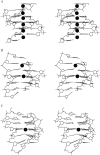Formation pathways of a guanine-quadruplex DNA revealed by molecular dynamics and thermodynamic analysis of the substates
- PMID: 12944293
- PMCID: PMC1303352
- DOI: 10.1016/S0006-3495(03)74608-6
Formation pathways of a guanine-quadruplex DNA revealed by molecular dynamics and thermodynamic analysis of the substates
Abstract
The formation of a cation-stabilized guanine quadruplex (G-DNA) stem is an exceptionally slow process involving complex kinetics that has not yet been characterized at atomic resolution. Here, we investigate the formation of a parallel stranded G-DNA stem consisting of four strands of d(GGGG) using molecular dynamics simulations with explicit inclusion of counterions and solvent. Due to the limitations imposed by the nanosecond timescale of the simulations, rather than watching for the spontaneous formation of G-DNA, our approach probes the stability of possible supramolecular intermediates (including two-, three-, and four-stranded assemblies with out-of-register base pairing between guanines) on the formation pathway. The simulations suggest that "cross-like" two-stranded assemblies may serve as nucleation centers in the initial formation of parallel stranded G-DNA quadruplexes, proceeding through a series of rearrangements involving trapping of cations, association of additional strands, and progressive slippage of strands toward the full stem. To supplement the analysis, approximate free energies of the models are obtained with explicit consideration of the integral cations. The approach applied here serves as a prototype for qualitatively investigating other G-DNA molecules using molecular dynamics simulation and free-energy analysis.
Figures












Similar articles
-
Structural dynamics and cation interactions of DNA quadruplex molecules containing mixed guanine/cytosine quartets revealed by large-scale MD simulations.J Am Chem Soc. 2001 Apr 11;123(14):3295-307. doi: 10.1021/ja002656y. J Am Chem Soc. 2001. PMID: 11457065
-
Molecular dynamics of DNA quadruplex molecules containing inosine, 6-thioguanine and 6-thiopurine.Biophys J. 2001 Jan;80(1):455-68. doi: 10.1016/S0006-3495(01)76028-6. Biophys J. 2001. PMID: 11159416 Free PMC article.
-
Thermodynamic and kinetic characterization of the dissociation and assembly of quadruplex nucleic acids.Biopolymers. 2000-2001;56(3):147-94. doi: 10.1002/1097-0282(2000/2001)56:3<147::AID-BIP10011>3.0.CO;2-N. Biopolymers. 2000. PMID: 11745110 Review.
-
A double chain reversal loop and two diagonal loops define the architecture of a unimolecular DNA quadruplex containing a pair of stacked G(syn)-G(syn)-G(anti)-G(anti) tetrads flanked by a G-(T-T) Triad and a T-T-T triple.J Mol Biol. 2001 Jun 29;310(1):181-94. doi: 10.1006/jmbi.2001.4759. J Mol Biol. 2001. PMID: 11419945
-
Recent progress in G-quadruplex DNA in deep eutectic solvent.Methods. 2013 Nov;64(1):52-8. doi: 10.1016/j.ymeth.2013.04.017. Epub 2013 Apr 27. Methods. 2013. PMID: 23628945 Review.
Cited by
-
Streamlining effects of extra telomeric repeat on telomeric DNA folding revealed by fluorescence-force spectroscopy.Nucleic Acids Res. 2019 Dec 2;47(21):11044-11056. doi: 10.1093/nar/gkz906. Nucleic Acids Res. 2019. PMID: 31617570 Free PMC article.
-
Cation-Responsive and Photocleavable Hydrogels from Noncanonical Amphiphilic DNA Nanostructures.Nano Lett. 2022 Jan 26;22(2):602-611. doi: 10.1021/acs.nanolett.1c03314. Epub 2022 Jan 13. Nano Lett. 2022. PMID: 35026112 Free PMC article.
-
Molecular dynamics simulations of RNA: an in silico single molecule approach.Biopolymers. 2007 Feb 5;85(2):169-84. doi: 10.1002/bip.20620. Biopolymers. 2007. PMID: 17080418 Free PMC article. Review.
-
Hinge-like motions in RNA kink-turns: the role of the second a-minor motif and nominally unpaired bases.Biophys J. 2005 May;88(5):3466-85. doi: 10.1529/biophysj.104.054916. Epub 2005 Feb 18. Biophys J. 2005. PMID: 15722438 Free PMC article.
-
Molecular dynamics simulations and their application to four-stranded DNA.Methods. 2007 Dec;43(4):278-90. doi: 10.1016/j.ymeth.2007.02.004. Methods. 2007. PMID: 17967698 Free PMC article.
References
-
- Andricioaei, I., and M. Karplus. 2001. On the calculation of the entropy from covariance matrices on the atomic fluctuations. J. Chem. Phys. 115:6289–6292.
-
- Aqvist, J. 1990. Ion-water interaction potentials derived from free energy perturbation simulations. J. Phys. Chem. 94:8021–8024.
-
- Arnott, S., and D. W. Hukins. 1972. Optimised parameters for A-DNA and B-DNA. Biochem. Biophys. Res. Commun. 47:1504–1509. - PubMed
-
- Arthanari, H., and P. H. Bolton. 1999. Porphyrins can catalyze the interconversion of DNA quadruplex structural types. Anticancer Drug Des. 14:317–326. - PubMed
Publication types
MeSH terms
Substances
LinkOut - more resources
Full Text Sources

